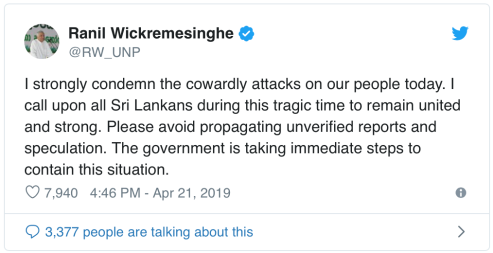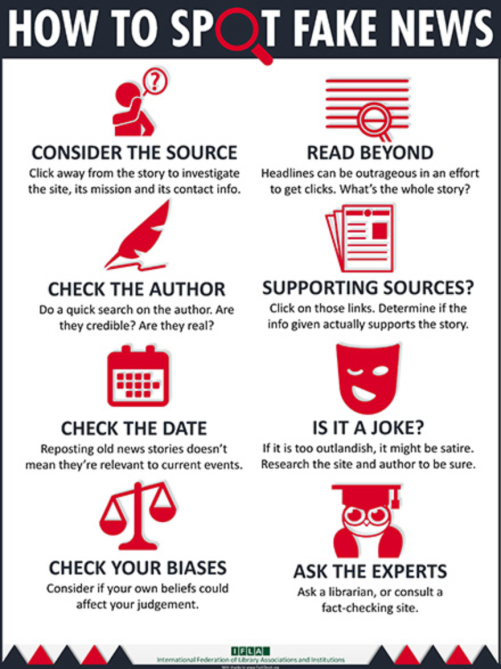What is Fake News?
Fake news involves stories that have been deliberately invented and designed to make individuals believe them to be true when they are not, or to buy a certain product, to visit a certain website or to make you believe something that works to their religious or ethical advantage to be true.
Traditionally we would get our news from trusted sources such as journalists and media outlets that were and still are required to follow strict codes of practice. However, our rapid movement online has enabled a whole new way to publish, share and consume information and news with very little regulation or even editorial standards.
According to Martina Chapman (Media Literacy Expert), there are three elements to fake news; “Mistrust, misinformation and manipulation.” The professional practice of journalism is being affected by the ethical issues related to Chapman’s three m’s.
There are various types of fake news:
- Clickbait:
Involves stories that are deliberately fabricated and have the aim of gaining website visitors and to increase advertising revenue for the websites. Usually headlined with sensationalist titles.
- Propaganda:
Stories that are created to deliberately mislead audiences, promote a biased point of view or particular cause or agenda. - Satire/Parody:
Publishing fake news stories solely for parody or entertainment, with many readers believing them to be true and spreading them further. - Sloppy Journalism:
Reporters or Journalists may publish a story with unreliable information or without checking all of the facts which can lead to misleading their audiences and themselves. - Misleading Headings:
Stories that are not completely false can be distorted using misleading or sensationalist headlines. This is dangerous on social media where only headlines and small snippets are displayed to their audiences. - Biased/Slanted News:
Social Media news feeds are wired to display relevant articles that they believe we will click on and read based on our personalised searches. This becomes a problem when people write news or stories that confirm their own biases or skewed beliefs.
Fake News in relation to world trauma
Misinformation online is continuing to have alarming real world consequences. It enables the influence of elections, to heightening panic and causing death, spreading fear and deadly unethical and religious unrest. People are very quick to try and fill the information gap with the pace of social media impeding the responsible verification process, a problem that Facebook, Google, Twitter and other social media sites have to fix.
Sri Lanka
On Easter Sunday, April 1 of 2019, more than 300 people died and a further 500 injured after a series of bombings at different churches and hotels across Sri Lanka. Within hours of the first bombings on Sunday morning, researchers said that they saw a spike in false reports regarding the perpetrators and the number of victims. These false stories and rumours were being spread widely and rapidly online.
Prime Minster Ranil Wickremesinghe asked through twitter for individuals to “please avoid propagating unverified reports and speculation.”

Very shortly after this tweet was sent out there was a followup of an outright ban on a series of social media sites such as Facebook, Facebook-owned WhatsApp and Instagram, Youtube, Snapchat and Viber that was announced on Twitter. The government said that the block would only be temporary, but remain in place “until investigations were concluded.”
One of the first questions asked when a tragedy like this happens will always be ‘who was behind this?’ Officials made up to 24 arrests in a short amount of time after the bombings but were tight lipped on who any of these suspects were. Despite this, there was a widespread speculation about the person or group behind the bombings online.
Many news outlets published names of suspects that had not been verified by officials. One video even named and showed a photograph of a man and claimed his connection with the bombings, receiving hundreds of thousands of views across Twitter and YouTube. There were more cases of attributing the attack to Muslim suicide bombers, along with a tweet from a Sri Lankan minister about an intelligence report warning of an attack. Both being fake news.
Is the ban a good idea?
Some individuals believe that the ban is an inevitable response to the inability of social media platforms to fix their problems of misinformation. Various tech commentators such as The New York Times and The Guardian were quick to show their support for the social media ban. They viewed the events as evidence of Facebook failing to stop the spread of misinformation and hate speech not just in Sri Lanka, but the world.
Despite this, there is debate against the negative blackout eliminating a key means of communication during such a dark terrorist event. Those desperate to get information from loved ones and to be informed of what was actually happening were unable to. Analysts, meanwhile, question whether shutting down social media is effective at defusing terror. The Brussels-based International Federation of Journalists has said there is no “substantive” evidence to show that such bans, common in South Asia, can “scale down violence.”
Banning social media to stop the spread of fake news also means that the misinformation cannot get debunked by professional journalists who do their own verification and further research.
The Impact Fake News has on Journalists
Journalists along with anyone else composing, spreading and sharing headlines, articles, pictures or information have to be diligent and aware of what it is they are actually putting into the world, along with the ethical implications of spreading the false information. This is particularly true during times of heightened tension or crisis when the levels of misinformation increases.
The International Federation of Library Associations has useful tips to help any journalist or individual who is unsure when it comes to checking on authenticity and how to contain the spread of misinformation:

IVLA on how to spot fake news.
There are also a number of websites who pride themselves on having accurate and real stories published on their websites, as well as giving you the ability to check on information, pictures and articles when deciding on legitimacy:
The Conversation: “Academic rigour, journalistic flair.”
Snopes: “Snopes is the internet’s definitive fact-checking resource.”
Reverse image search from Google: You can find related images when using this reverse image search.
PolitiFact: “Our core principles are independence, transparency, fairness, thorough reporting and clear writing.”
Verification
I believe that the verification process is really the core ethical principle that can and will combat fake news. Bill Kovach and Tom Rosenstiel are founders of numerous organisations with the aim to better the quality of journalism, the Committee of Concerned Journalists (CCJ) and the Project for Excellence in Journalism (PEJ).
Both founders stated that “the essence of journalism is a discipline of verification,” so journalists have to ensure they are committed to this accuracy. Verification validates journalism as a profession and something to be admired, instead of the worldwide negative effects they can produce and influence.
In their book, The Elements of Journalism, Kovach and Rosenstiel accurately conclude that, “in the end, the discipline of verification is what separates journalism from entertainment, propaganda, fiction, or art.”